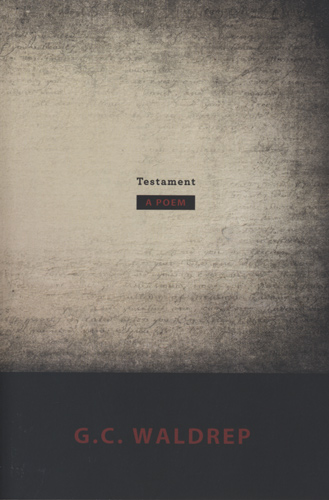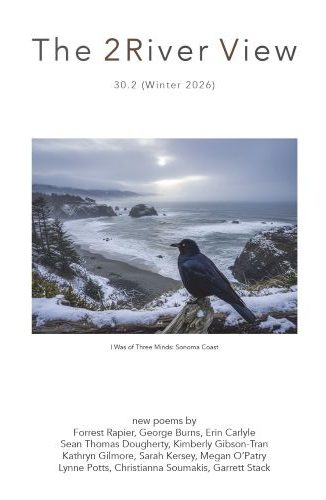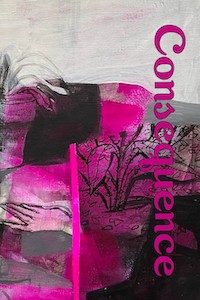“The body as sculpture,” Testament—G. C. Waldrep’s book-length poem—begins, and with it we feel the steadying gesture that prefaces any great feat—fingers at one’s temples, eyes closed, the breath held. “The body as sculpture,” Testament—G. C. Waldrep’s book-length poem—begins, and with it we feel the steadying gesture that prefaces any great feat—fingers at one’s temples, eyes closed, the breath held. He goes on:
The body as sculpture. (Pageant, labyrinth.)
Wrapped like Central Park or Marin
in Christo’s silk, wiving into a future
of minerals and taffeta, hypocausts and gorse.
We have computers to calculate the rocket’s
rate of descent, its pure metaphor.
And we see right away what sort of virtuosity—one hundred and thirty pages of it—lies before us: the precision of image, the sonority of language, the diversity of tone and approach. And good god that lexicon. Here is a sampling from my dictionary searches: pericarp, catenary, sonogram, anaclitic, infundibulum, blowsy, moire, thaumaturge, asperges, agitprop, tonsure, anneal, croft, evulsion, and on and on.
“Waldrep offers us,” as Dan Beachy-Quick says in his fantastic blurb, “his most necessary book,” and I’m very much inclined to agree—this is, to me, pure Waldrep, a distillate of his finest maneuvers, and in many ways the most ambitious of his meditational efforts. To that end, this is a rangy poem, shifting and cycling back on itself, plumbing and measuring and reassessing in a long stream of discursions separated into five parts and, dividing those, regular intervals of glyphs.
What has always impressed me about Waldrep is the high quality of his images, which always seem to glow with a perfect balance of scientific precision and emotional resonance. Turn to any page and you get things like:
The cone of night spindling
inland, this far north of the equator.It is always just a little bit about dying.
The buckles and stays. The flight-pressed estuary.
So often he can pull off this balance, dense images such as “cone of night” and “flight-pressed estuary” conditioned by abstract ideals and self-reflexive gestures: “It is always just a little bit about dying.” The poet is there to remind us that poetic image is always also a speech act, and that meaning is always suspended somewhere between ideas and perceptions.
Waldrep engages language mimetically to showcase this point, but he also directly addresses it as a primary force in the universe. This is most prevalently seen in refrains that proffer different definitions of the word “predicate.” For example: “Predicate: the mask with its fleshy / retinue, adrift over the fields / like so many mathematical kites.” “Predicate: all the bodies your body / could be, was, could have been.” “Predicate: to assert, affirm, / preach, declare. To have poisoned, / to have carried or clothed.” And one more, particularly astute:
Predicate: to record this motion.
To have so recorded. Word as object, planet,
distal summoning. Rosebank at duskfall:
something in it. Something from it.
Waldrep activates language and stretches it to a “distal summoning,” making it a form of ontology that is in constant motion, a continuous coming-into-being.
Balancing this sense of language as incarnation is a concern with other forms of media as kinds of incarnation. A projector seems to be running all the time in the background of this poem (one certainly thinks of T. S. Eliot’s “magic lantern”), and often the projector comes into the foreground as a locus of ontological rupture: “The projector tears open its own throat-beam / of light and expects everything else— / all matter—to do likewise.”
Pivoting off of media and language is yet another prevalent set of definitional refrains, on gender. These are more often posed as questions than dictionary entries, and of the many I’ll offer just this example: “Is gender, then, a lyric form, ventriloquy / of the body and its clastic fashioning? Or is it / just another prop, left over from some other landscape, some other film.” What we come away with is a (now) classic sense that ontology is built on otherness, on the gulf between one’s own body and that of other people, beings, and objects. And this otherness is caught-up in epistemological acts. At a few points (yet another refrain), Waldrep encapsulates this sense of epistemology and otherness in a particularly pared-down—and effective—image: “Emended trinity: eye, bee, flower.” We observe (the light that reflects the scene) the bee (an Other), and the bee’s target (enticing, sexualized) of the flower (its Other).
Light, ontology, otherness, gender, engendering—these shape, then, Waldrep’s rhetorical approaches. We get expository passages on history (as knowledge). We get his engagement with other texts (in fact, the poem began as a review of/response to works by Lisa Robertson, Carla Harryman, and Alice Notley, as indicated in the notes). We get invisible interlocutors (there are frequent allusions to a conversation taking place to the side of the poem, with lots of ‘you say’s stitched to the ends of his sentences). We get humor and earnestness; composure and frenzy (differences in mood that destabilize the singularity of the speaker). And synthesizing all of these is a bevy of cinched-up conclusions—sometimes aphoristic—that at once stand back from the poem and prod it forward. A few examples: “The cosmos / whirs along in its delicate tracery and we / are the hair it’s shedding.” “The grief of language is that there is, finally, / no Other. Only the body, transposition / in scale and meter, black patch on which language skids.” And finally: “I still think story is the more generous gift / though it fails and, in failing, drives / whole economies towards consolation.”
Testament is the sort of poem you have to wander through. It is ambitious and athletic, ever-climbing (like Icarus, who appears often) toward a breakthrough. The results can be messy, and not everything here fully arrests, but the endurance of attention has great rewards, and the poem promises lasting power and new insights with each reread.





